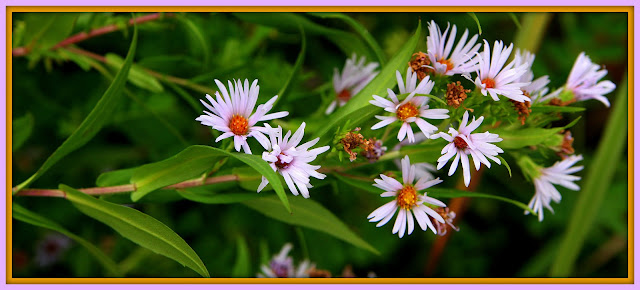Asters are one of the last wildflowers to bloom in our area of S.W. Michigan.
The bees are extending the season; taking the opportunity to gather pollen.
My various wildflower books display 19 species in one book, 15 species in another, five, and four in others. It's all very confusing.
Older books differ from newer books, so identification is very difficult.
They exhibit different growth patterns, depending on the site, and competition for light.
Many species commonly interbreed, and are difficult to distinguish.
The colors can vary within the same species, or even change color slightly, during the
growing season.
This widespread perennial is found in a wide variety of wet and dry habitats, but most species love the sun and grow in open areas or edges.
The word Aster comes from a Greek word meaning star, as in asterisk ... * or astromomy, astronaut, etc.
Perhaps some experts who really know their Asters can help me learn more. Meanwhile, just enjoy the variety of forms and colors.
This has been a short piece of Botany...
... and you have only a short time to explore outdoors.
Some asters will last
a few days in a vase
if you need some late flowers
to cheer up your place.
Right now a fast honeybee
is acting aggressive you see.
It's getting too near I fear,
so would you please excuse me
while I zoom out of here!
(Click on any photo to enlarge)
Bushy Aster / Marsh Aster (Aster simplex)
Red-stemmed Aster / Purple-stemmed Aster (Aster punicous)
Smooth Blue Asters (Aster laevis)
New England Aster (Aster novae-angliae)













No comments:
Post a Comment
VISITORS:
Please write a comment in the white box. I value your thoughts. I will reply to all who write.
When finished, sign your name, click down arrow, select "Name/URL", or "Anonymous", then click "Publish". Thank you.